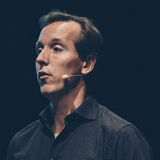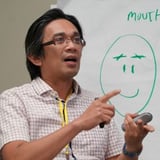Summary
Phil Gilbert details IBM's transformative design initiative started in 2012 aimed at embedding design deeply within a massive engineering-driven culture. The program focuses on cultivating a sustainable design culture through a 'culture quotient' framework that measures artifacts created, the culture's embrace of these artifacts, and their longevity. IBM committed to hiring 1,000 formally trained designers to fill a critical gap, simultaneously creating partnerships with top design universities and building rigorous internship programs led by Devon O'Brien from SCAD. Gilbert emphasizes that change requires a collective opt-in, multidisciplinary teams, and avoiding top-down imposition to drive adoption effectively. They advanced IBM Design Thinking, a lightweight, scalable approach fostering collaboration beyond designers to product managers, marketing, finance, and legal teams. IBM reinvented its workspaces, notably the Austin studio, focusing on flow and movement rather than static open space—driven by practical innovations like mobile, reconfigurable walls. Notable people involved include Adam Cutler overseeing 1,500 designers, Doug Powell managing education for 380,000 IBMers, and university hires like Denise Burton and Doug Powell bringing deep industry experience. Gilbert highlights IBM's shift from rigid design system uniformity to a flexible design language that empowers choice and implementation independence. The program also leverages modern collaboration tools (Slack, GitHub, Mirally) and global studios in Germany, UK, China, and Tel Aviv to nurture a connected design community. The transformation is a long-term commitment, with visible cultural change expected by 2018-2020, driven by passionate buy-in, reinforced by quick wins, and powered by design leaders like Elliott Noise promoting unity without uniformity. Gilbert ends with a story from Devon O'Brien on teaching collaboration and graceful failure to interns as the essence of IBM’s design culture.
Key Insights
-
•
IBM's design transformation is driven by a culture quotient formula: artifacts generated, cultural embrace, and duration of adoption.
-
•
A sustainable design culture requires engaging everyone, not just designers, through an opt-in approach.
-
•
IBM set a goal to hire 1,000 formally trained designers in five years, partnering with top design universities worldwide.
-
•
Design thinking at IBM is practiced by over 100 multidisciplinary product teams involving non-design roles like marketing and legal.
-
•
IBM’s design language is flexible and implementation agnostic, moving away from rigid uniform front-end frameworks of the past.
-
•
Physical workspaces, like IBM’s Austin studio, emphasize movement, modular walls, and maker spaces instead of static open offices.
-
•
A robust, rigorous intern program called Maelstrom, created by Devon O’Brien, embeds interns in real, high-impact projects sponsored by IBM's business units.
-
•
The program ensures designers have formal career paths equivalent to engineers, including distinguished titles and recognition.
-
•
To scale culture change, IBM leverages modern collaboration tools like Slack, GitHub, Mirally, and live streaming of paper artifacts.
-
•
Elliott Noise's principle of unity, not uniformity, guides IBM’s design culture to embrace diversity while working toward common goals.
Notable Quotes
"We embarked on a program to create a sustainable culture of design across 380,000 people at IBM."
"Culture quotient is artifacts times embrace times duration — that’s how you understand culture."
"You have to do everything with everybody in order to affect change."
"IBM Design Thinking isn’t just about designers; it’s about product managers, engineers, marketing, finance, legal—everybody."
"We chose an opt-in program because forcing design top-down would have failed."
"Our design language gives people choices, it's implementation agnostic, and it’s not a guideline but a language."
"Our Austin studio was purpose built with mobile walls to create movement and flow, not just static open space."
"We went from having no formal design career path to offering titles like Design Principal, equal to Distinguished Engineer."
"Design thinking is the scientific method for the 21st century."
"We show people how to collaborate like crazy and how to fail gracefully."
Or choose a question:
















More Videos

"The 1500 are designers, we don't distinguish strictly between UX or visual or industrial—they all bring design to the org."
Adam Cutler Karen Pascoe Ian Swinson Susan WorthmanDiscussion
June 8, 2016

"UXers are less satisfied than their peers because we have failed to set expectations about the real work of UX in organizations."
Peter MerholzThe Trials and Tribulations of Directors of UX (Videoconference)
July 13, 2023

"In the automotive industry, most safety standards only became mandatory after governments intervened."
Lisa WelchmanCleaning Up Our Mess: Digital Governance for Designers
June 14, 2018

"Investing in sustainability today will yield dividends for future generations."
Vincent BrathwaiteOpener: Past, Present, and Future—Closing the Racial Divide in Design Teams
October 22, 2020

"The greatest sign of success for a teacher is just to be able to say the children are now working as if I did not exist."
Brenna FallonLearning Over Outcomes
October 24, 2019

"Linear perspective created this myth that we can see reality from a single perspective, which is the source of all misunderstanding."
Tricia WangSpatial Collapse: Designing for Emergent Culture
January 8, 2024

"If you don’t bring stakeholders into the research journey, they won’t believe or use the data."
Edgar Anzaldua MorenoUsing Research to Determine Unique Value Proposition
March 11, 2021
"Service lines bridge the gaps between product lines through information flows to provide the right knowledge at the right time."
Designing Systems at Scale
November 7, 2018

"Ethics evolve faster than law; just because something is legal doesn’t mean it’s ethical."
Erin WeigelGet Your Whole Team Testing to Design for Impact
July 24, 2024
















